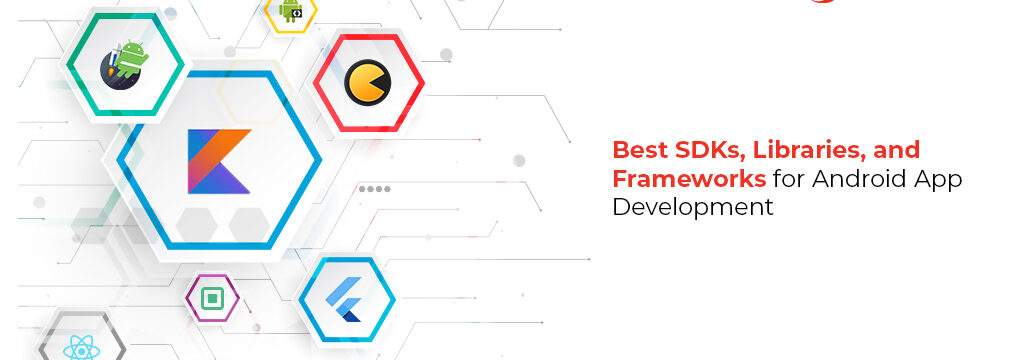Since Google brought us Android for the first time back in 2007, it has turned into smartphone OS shark in the market. Android has come a long way, growing exponentially with a wide range of devices, which vary in hardware covering budget Android smartphones to expensive state-of-the-art flagship devices. Android dominates not just smartphones but also has a tangible presence on electronics like smart TVs and watches today.
For Android app developers, the main challenge is to create apps that accomplish a lot without a single roadblock. Thanks to this blog, today you will be given an assemblage of the best Android app development libraries and frameworks. Read on to know all about it!
Frameworks: Android App Development
There are plenty of frameworks for Android available, which comprises of several cross-platform frameworks. Let’s take a quick look at each of them for better understanding.
Kotlin and Android SDK
Kotlin is a great programming language with first-class highlights such as null safety, Extension functions, Lambda expressions, and Coroutines. Developers will appreciate the minimized boilerplate code they would need to create as compared to Java. The arbitrary semicolon(;) at the finish of each code line is an absolute pleasure to have as a feature.
If a developer intends to work with different kinds of devices such as Wear OS wearable devices or Google TV, then they may not get a wide choice; choosing Native development kits is a better option since nearly none of the cross-platform SDKs provide support for such devices.
Flutter
Flutter facilitates developers to create stellar UI experiences with its declarative and approach which works easily on all platforms like Android, iOS, and Web. The seamless performance will surprise you across all platforms.
Flutter is now also available for Desktop. Using Flutter for apps is a no-brainer since it can also be integrated to existing apps with the help of Flutter add-to-app.
Flutter is pretty simple to start working on but it can be an adjustment for developers with a functional programming approach while facing complexities.
Flutter renders its own widgets, which provide the same degree of accuracy and performance on multiple platforms. However, as stated before, it’s not going to be the first to release UI/UX updates by the respective owners of the ecosystem.
React Native
React Native is the third-greatest platform after the pioneers Android and iOS for app development. Without a doubt, React Native is the prime cross-platform SDK for mobile app development. It has been the primary choice for a substantial group of JavaScript developers because of JSX being used.
If you’re wondering, this is a certified SDK with a list of renowned apps by Facebook.
On the other hand, React.js UI made with Flutter can run on multiple platforms without any problems.
Libraries for Android App Development
Libraries have a major part to play in any framework’s development process. It lowers the effort required to create things developers use most often during the process. Here are your best options for Android App Development Libraries.
Android Jetpack
Google had announced a group of libraries for native Android app development in Google I/O 2018. It assists developers to use best practices, create codes that work consistently across all versions of Android or devices, and cuts down on boilerplate code.
Frameworks: Dependency Injection
Dagger2 or Hilt
While talking about dependency injection, we consider Dagger2 at the top of our list. The Android team released a version called Hilt. Dagger works on the basis of annotations as it is a static dependency injection framework.
Koin
Koin is a Kotlin injection framework and takes lesser configuration when compared with Dagger2. It also facilitates ViewModels and lazy injection while producing even lesser boilerplate code as compared to Dagger 2.
Networking
Retrofit
Retrofit is one of our most preferred type-safe HTTP clients for Java and Android. It is simple to execute the preferred developer choice and supports popular serialization libraries.
Volley
Volley by Google supports scheduling network requests; if developers are seeking a network client for every network operation along with image loading, Volley is a great pick.
Image loading
Glide
Glide makes it simple to fetch, display video stills, animated Gifs, and images. It presents a flexible API to enable developers to plug into any stack of networks.
Fresco
The Facebook-backed Fresco loads image faster than Picasso. It also helps applications run faster and cuts down the OutOfMemoryError.
Coil
Coil is the first Image loading library fully built by Kotlin and also supports Coroutines. It is quick, modern, easy to use, and light.
Analytics and Crash Reporting
Firebase Analytics and Crashlytics
Firebase is our favorite solution for Android apps in the niche of analytics and crash reporting. It performs real-time tracking of crash reports. Developers can define their personalized events to track user behavior.
Android Libraries
Overlap-Image-View
This is one of the most flexible libraries to help create overlapping images on the Android app. It also supports all popular image loading libraries such as Fresco, Glide, or Coil.
Vanilla-place-picker
This simple and nifty solution helps you pick places being backed by Google Autocomplete SDK and Google Maps. It facilitates a UI to showcase an interactive map along with autocompleting functionality based on place prediction and user input.
Wrapping Up:
There are a huge variety of choices when it comes to mobile app development frameworks, libraries, SDKs, and others in the market and we brought you the best of them all. Knowing these frameworks, libraries, and SDKs will surely assist you to improve the quality of Android apps. We hope that you found our blog helpful and can take valuable information from it.


